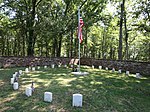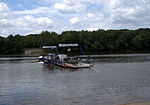Battle of Ball's Bluff

The Battle of Ball's Bluff was an early battle of the American Civil War fought in Loudoun County, Virginia, on October 21, 1861, in which Union Army forces under Major General George B. McClellan suffered a humiliating defeat. The operation was planned as a minor reconnaissance across the Potomac to establish whether the Confederates were occupying the strategically important position of Leesburg. A false report of an unguarded Confederate camp encouraged Brigadier General Charles Pomeroy Stone to order a raid, which resulted in a clash with enemy forces. A prominent U.S. Senator in uniform, Colonel Edward Baker, tried to reinforce the Union troops, but failed to ensure that there were enough boats for the river crossings, which were then delayed. Baker was killed, and a newly arrived Confederate unit routed the rest of Stone’s expedition. The Union losses, although modest by later standards, alarmed Congress, which set-up the Joint Committee on the Conduct of the War, a body which would provoke years of bitter political infighting.
Excerpt from the Wikipedia article Battle of Ball's Bluff (License: CC BY-SA 3.0, Authors, Images).Battle of Ball's Bluff
Yellow Trail, Leesburg
Geographical coordinates (GPS) Address Nearby Places Show on map
Geographical coordinates (GPS)
| Latitude | Longitude |
|---|---|
| N 39.1282 ° | E -77.5277 ° |
Address
Yellow Trail
Yellow Trail
20176 Leesburg
Virginia, United States
Open on Google Maps








